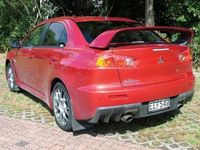Article and photography by Mike Stock. Reprinted with permission from ACP Media (AutoTrader)
 The letter M, or words starting with M, have always leapt into my mind when I think about the Lancer Evo. Sure Mitsubishi starts with M, but it's two other words that do the niggling: mystique and mystery. Mystique's place here is clear. Lancer Evos are cars with plenty of mystique.
The letter M, or words starting with M, have always leapt into my mind when I think about the Lancer Evo. Sure Mitsubishi starts with M, but it's two other words that do the niggling: mystique and mystery. Mystique's place here is clear. Lancer Evos are cars with plenty of mystique.
The Lancer Evo took over as Mitsubishi's rally weapon after the porky and tricky Galant VR-4, and the Evo's mystique was bred on rally special stages in the hands of the then seemingly unbeatable multiple world champion, Tommi Makinen. But it's the word mystery that has nagged away at me when I think about Evos. Mystery that such an accomplished car one with several world rally championships under its belt could have evolved from such a mediocre (M again) car as the basic Lancer sedan.
By the time the Evo 9 came around, the standard Lancer was looking very much a cynical exercise; a car well past its use-by date. A car that was sold largely to older private buyers and rental car fleets, and which came in several iterations over the years, sourced from Japan and from Southeast Asia. Some of the latter had appallingly cheap-looking plastic interior trim, and seat fabrics that could generate enough static electricity as they reacted with your clothing that you could actually see the spark jump as you inserted the key to lock the door.
Yet from this unpromising basis, Mitsubishi's high-performance division was able to fashion a series of rally cars that won Group A and Group N championships, at world and national level. As rally cars they were fast, with torquey engines and a chassis that needed a fair share of manhandling. They were immensely chuckable where their arch-rival, the Subaru Impreza WRX STi, needed a straightline, almost circuit racing approach.
The mystery factor has gone with the latest version of the Lancer Evo, the tenth in the line, the Evo X (Latin numeral for the Arabic 10). Or is it the 11th Evo, given that there was an Evo 6.5? For this car is based on the first really new Lancer in years, a car that is as thoroughly up-to-date as its predecessors were obsolescent.
The new standard Lancer sedan is a very good car, with good handling (an area in which its predecessors under-achieved) and a solid feel. It's also a bigger car which has led to folklore about the Evo X version being too big to be the basis of a successful
rally car.
The perceived wisdom is that people planning to go the Three Diamond brand route in local rallying have been buying up every Evo 9 they can get their hands on. But Neil Allport, New Zealand boss of Mitsubishi's Ralliart division, is said to be building an Evo X which he'll field for contracted drivers in world rallies later this year.
 So, has the Evo now become too big? Is it a car now more in keeping with the accomplished, though too big to be a rally special, Galant VR-4? Has the Evo lost some of its X-factor? On the strength of our time with a red Lancer road car, the answer to the last question is an unequivocal no. We were blown away by the last high-performance Lancer we tested, an Evo 9, and the way it handled and went, though we were under-whelmed by the way it looked. But the X looks like business, from the new trademark, open-mouthed, hapuka-like grille/air intake to the aerodynamically-effective boot lid spoiler. Not an elegant car, perhaps, but one whose looks are filled with purpose.
So, has the Evo now become too big? Is it a car now more in keeping with the accomplished, though too big to be a rally special, Galant VR-4? Has the Evo lost some of its X-factor? On the strength of our time with a red Lancer road car, the answer to the last question is an unequivocal no. We were blown away by the last high-performance Lancer we tested, an Evo 9, and the way it handled and went, though we were under-whelmed by the way it looked. But the X looks like business, from the new trademark, open-mouthed, hapuka-like grille/air intake to the aerodynamically-effective boot lid spoiler. Not an elegant car, perhaps, but one whose looks are filled with purpose.
And on the road, it has the chops both in performance and handling to more than deliver the performance its aggressive looks and stance promise.
The heart of the Evo X is the 1998cc, turbocharged and intercooled MIVEC double overhead camshaft four-cylinder motor. The 16-valve unit runs a 9.0:1 compression ratio and develops 206kW (a shade over 290bhp) of maximum power at 6500rpm, and a hefty 422Nm of peak torque at 3500rpm. It's a strong-feeling unit, with a gruff exhaust note and a fine, cammy howl at
high revs. It endows the Evo X with stunning performance, nudging the Supercar envelope.
We don't have accurate equipment to measure acceleration and anyway, 0-100 times are of most use as a way of indicating comparative performance with other similar cars. But US magazine Road & Track zipped its Evo X test car to 96kph (60mph) in 4.9 seconds, but it had the six-speed dual-clutch automated manual gearbox: our test car (priced at $62,990) had a conventional five-speed manual, though the six-speed auto/manual is available here ($67,990). The five-speed Evo X should hit 100kph in 4.7 seconds, and have a top speed in the 250kph range.
So, it's quick.
Behind the wheel, the acceleration is vivid perhaps not quite as brutal as the Evo 9's but still blisteringly quick. And manageable: under hard acceleration the car doesn't squirm, and though the corners come at you fast, the Evo gives you plenty of confidence that you have everything under control. That poise is helped by a raft of electronic stability aids that keep the Evo X on-track, and allow less than expert drivers to push into its considerable handling envelope safely. You'd have to do something very silly to get into real trouble in an Evo X.
The nicely-chunkily-rimmed steering wheel is ideally-placed, and the clutch action is precise and firm without being heavy. The five-speed gearbox shifts smoothly and quickly, though the meaty torque means bolt-action-fast gearshifts aren't really necessary. The seating position is low, giving you an at-one feel with the car: the only drawback is the combination of the low line of vision, thick A-pillar and exterior mirror right in your line of sight in tight right-hand corners. That low seating position and the pulse-quickening exhaust note combine to give a strong impression of speed, even when a quick glance at the speedo shows you're only doing 100kph. Porsche's 911 Carrera gives a similar impression of pace at relatively low speeds.
You can have an awful lot of fun and get enormous satisfaction from driving an Evo or a 911 for that matter on tight and twisting roads without exceeding the speed limit. Of course, both cars have such poise that they'll remain composed and stable at half as much speed again. The Lancer feels solid on the road, and has a ride that is firm yet compliant: it will hammer over bumps without losing chassis refinement.
The steering is well-weighted and communicative, though some critics have labelled it dull. We found it fine. It's accurate, quick and gives good feel. On a favourite section of twisting and demanding public road, the Evo X was sublime. The Brembo brakes front discs 350mm with four-pot calipers, rears 330mm were superb, showing no trace for fade even in very hard use on roads packed with second gear corners and third/fourth gear sprints in between.
You're working reasonably hard the cornering G-forces give your body a workout but the excellent Recaro sports seat keeps you in place and there's no need to brace your leg during hard cornering. There's room for five in the spacious cabin, though rear seat passengers won't enjoy themselves if the driver is using the car hard.
 The Evo X is well-equipped, from its 18-inch BBS alloy wheels with 245/40 R18 tyres to its standard alarm system with engine immobiliser and data-dotting. You get a leather-wrapped steering wheel and gear lever knob; dual tailpipes; central door-locking and keyless entry and start-up. The ignition is activated if the key unit is in your pocket or the car's cabin. To start the car you twist a knob placed roughly where the conventional key slot would be. There are power windows and power-adjustable exterior mirrors, tinted side windows with UV reducer climate-control air-conditioning; trip computer, and an MP3-compatible sound system with six speakers.
The Evo X is well-equipped, from its 18-inch BBS alloy wheels with 245/40 R18 tyres to its standard alarm system with engine immobiliser and data-dotting. You get a leather-wrapped steering wheel and gear lever knob; dual tailpipes; central door-locking and keyless entry and start-up. The ignition is activated if the key unit is in your pocket or the car's cabin. To start the car you twist a knob placed roughly where the conventional key slot would be. There are power windows and power-adjustable exterior mirrors, tinted side windows with UV reducer climate-control air-conditioning; trip computer, and an MP3-compatible sound system with six speakers.
Omissions? Lack of driver's seat height adjustment. But in general: well-equipped. The fuel tank holds 55 litres which means fairly frequent visits to the gas station if you're using the Evo hard (we saw average fuel consumption in all running city, highway, motorway and pressing-on of 13.4 litres/100km). And fuel is the Evo X's greatest shortcoming. It will run only on 98 octane premium petrol, and 98 octane isn't available everywhere in New Zealand. You can't buy it in the energy province, Taranaki, for instance.
The Lancer Evo X is a highly-desirable car, loaded with X-factor. It's capable of stupendous performance, yet is tractable and practical in city commuting. An expert driver will be able to wring astonishing feats from the car, yet the Evo is easy to drive and has no real vices. Indeed, it's a true sports sedan for the 21st century.









Join the Discussion
Type out your comment here:
You must be logged in to post a comment.